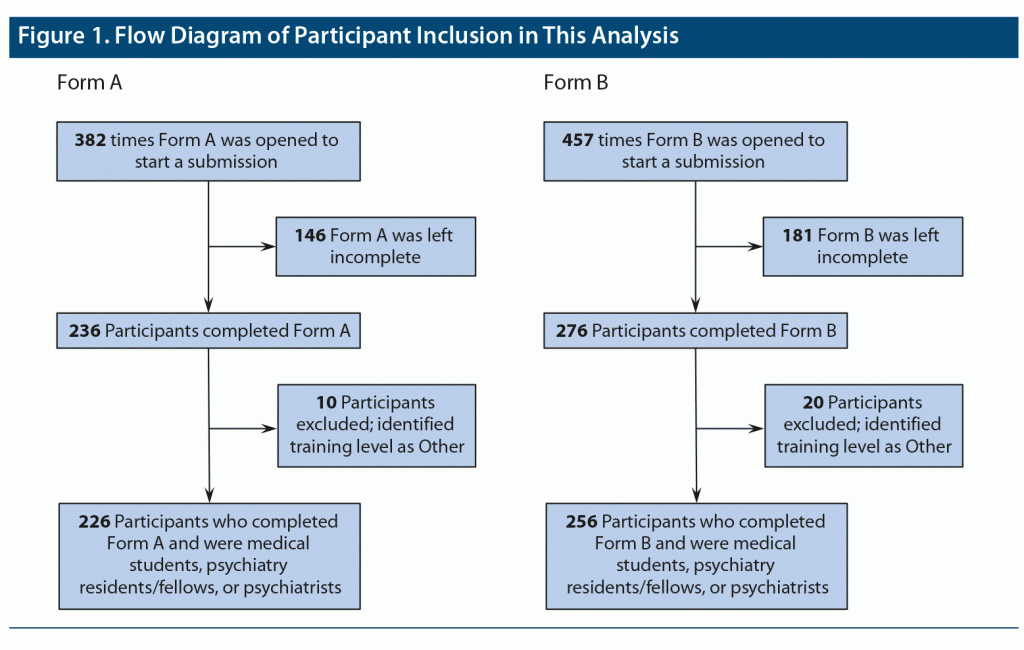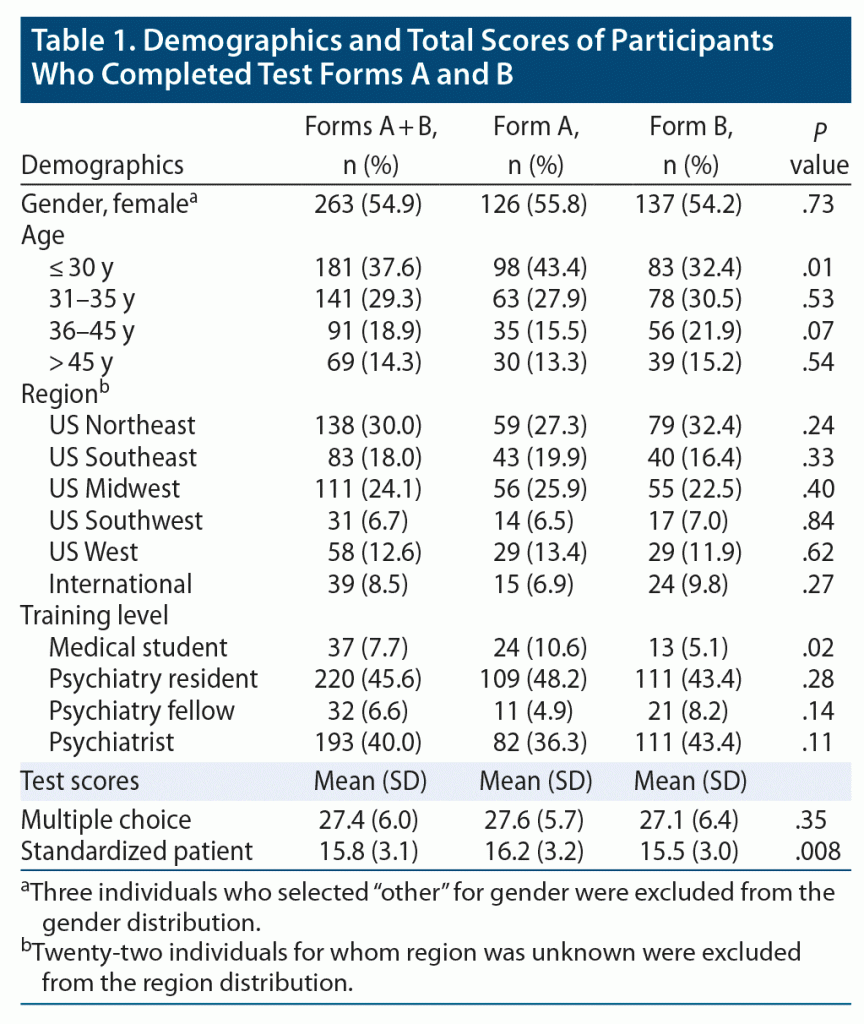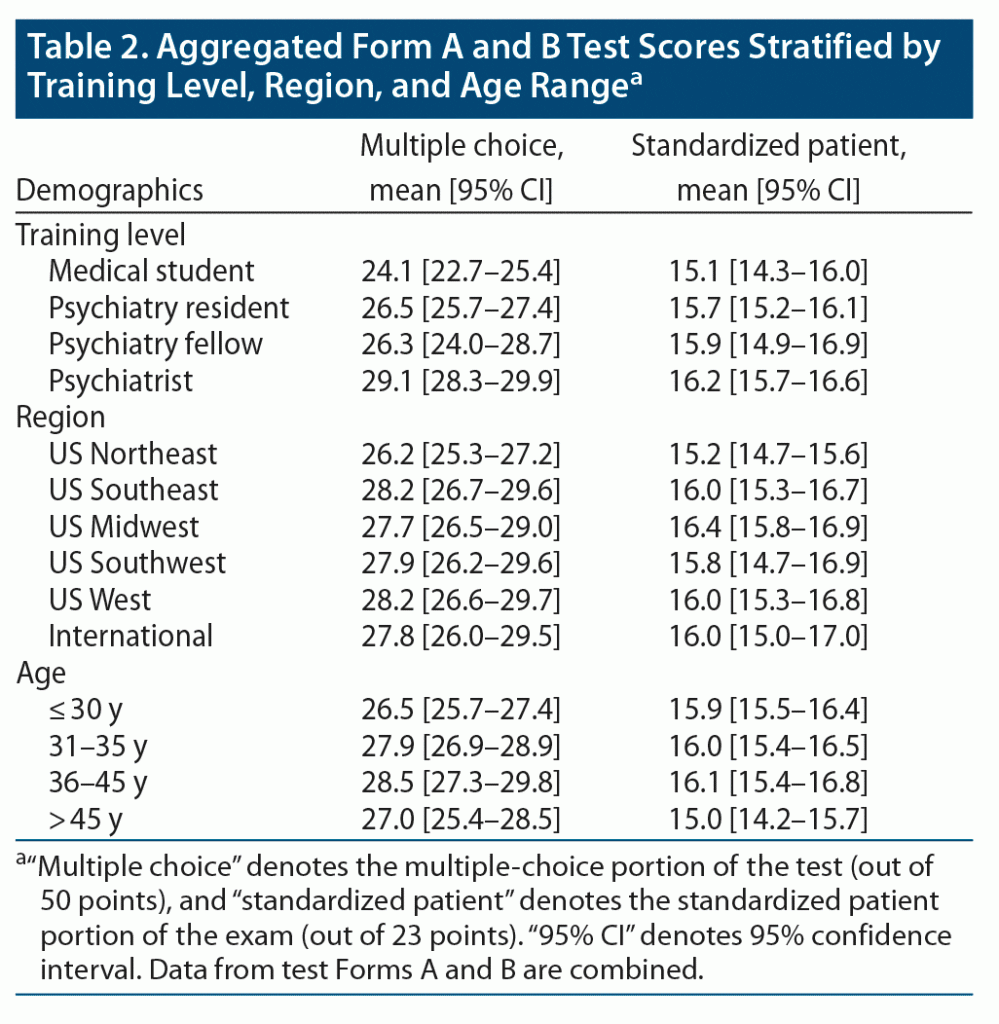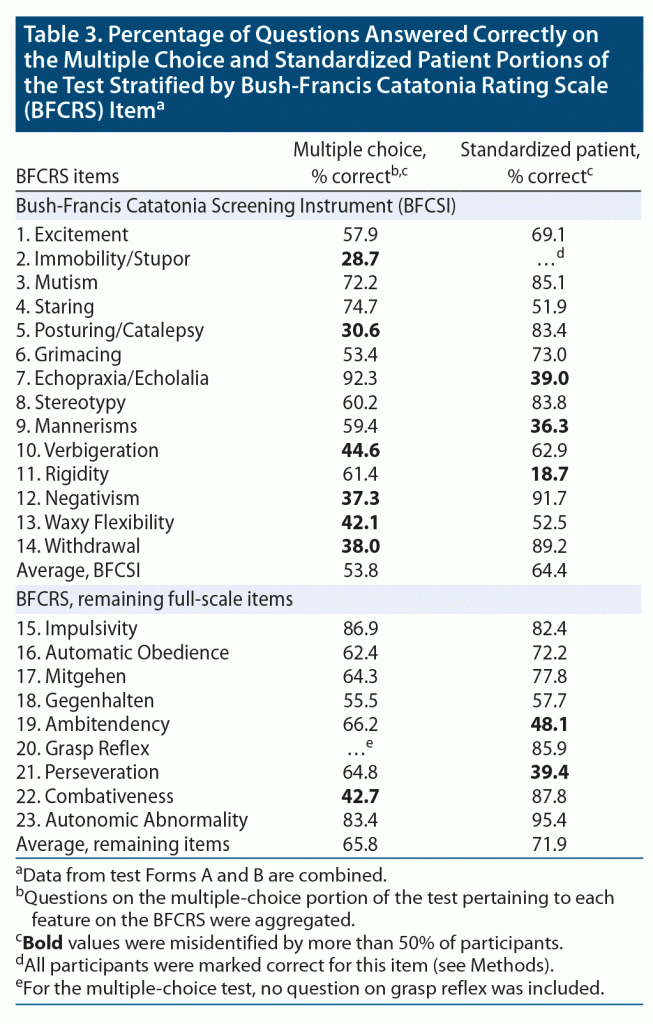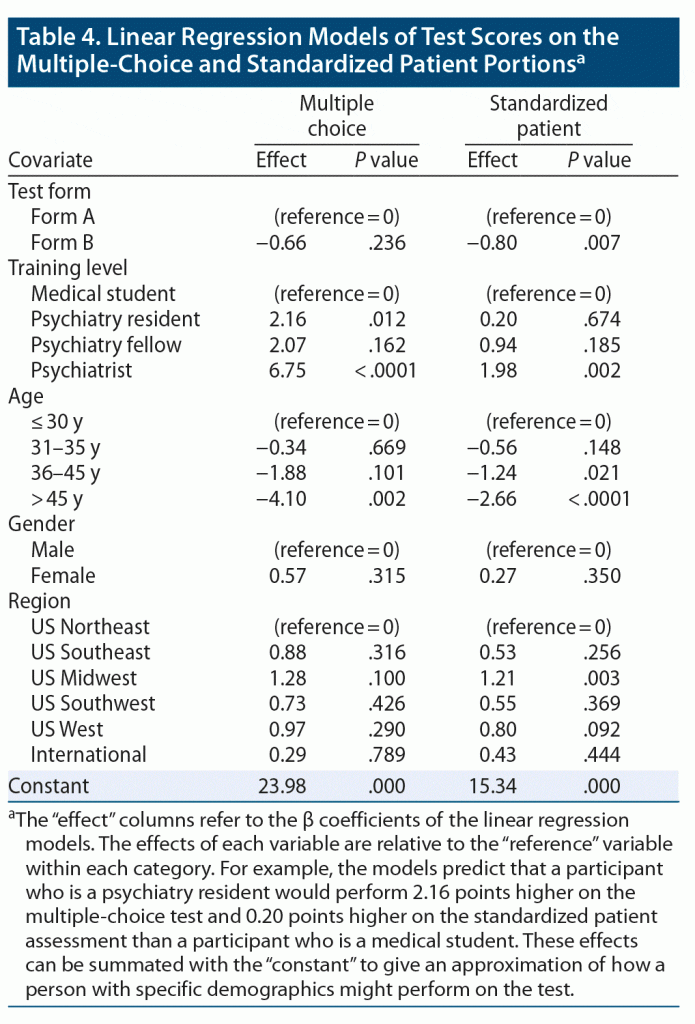ABSTRACT
Background: Catatonia is often overlooked, and a key factor for underdiagnosis may be an inadequate understanding of catatonia’s heterogeneous phenotypes. The aim of this study was to identify the current state of theoretical and applied knowledge of catatonic features among psychiatry trainees and practitioners using the Bush-Francis Catatonia Rating Scale (BFCRS), the most commonly used instrument to identify and score catatonia.
Methods: We created an online 50-item multiple-choice test and 3-minute standardized patient video to be scored using the BFCRS. Email invitations were sent to medical students and psychiatry residents and fellows through listservs of psychiatry clerkship and residency directors and to consultation-liaison psychiatrists through the Academy of Consultation-Liaison Psychiatry. Participants could access the exam from October 1 to December 31, 2020.
Results: In our sample (n = 482), participants correctly answered an average of 55% of test questions and identified 69% of BFCRS items on the standardized patient exam. Multivariable regression adjusting for demographics revealed that, compared to medical students, psychiatrists scored 7 points higher on the multiple-choice test and identified only 2 more items correctly on the BFCRS. Older participants performed worse than younger participants. No meaningful performance differences were identified by region or gender. Several items were consistently misidentified.
Conclusions: We found significant inaccuracies in clinicians’ understanding of catatonic features irrespective of their stage of training and years of experience. These data suggest prevalent gaps in catatonia recognition among psychiatrists, psychiatry trainees, and medical students utilizing the BFCRS. This has important implications for clinical research and patient care.
J Clin Psychiatry 2021;82(5):21m14025
To cite: Wortzel JR, Maeng DD, Francis A, et al. Prevalent gaps in understanding the features of catatonia among psychiatrists, psychiatry trainees, and medical students. J Clin Psychiatry. 2021;82(5):21m14025.
To share: https://doi.org/10.4088/JCP.21m14025
© Copyright 2021 Physicians Postgraduate Press, Inc.
aDepartment of Psychiatry, University of Rochester, Rochester, New York
bDepartment of Psychiatry and Behavioral Health, Pennsylvania State University, Hershey, Pennsylvania
*Corresponding author: Joshua R. Wortzel, MD, 300 Crittenden Blvd, Box PSYCH Rochester, NY 14642 ([email protected]).
Find more articles on this and other psychiatry and CNS topics:
The Journal of Clinical Psychiatry
The Primary Care Companion for CNS Disorders
CME Background
Articles are selected for credit designation based on an assessment of the educational needs of CME participants, with the purpose of providing readers with a curriculum of CME articles on a variety of topics throughout each volume. Activities are planned using a process that links identified needs with desired results.
To obtain credit, read the article, correctly answer the questions in the Posttest, and complete the Evaluation. This activity is free.
CME Objective
After studying this article, you should be able to:
- Avoid common errors in the identification of catatonia
Accreditation Statement
The CME Institute of Physicians Postgraduate Press, Inc., is accredited by the Accreditation Council for Continuing Medical Education to provide continuing medical education for physicians.
Credit Designation
The CME Institute of Physicians Postgraduate Press, Inc., designates this journal-based CME activity for a maximum of 1 AMA PRA Category 1 Credit™. Physicians should claim only the credit commensurate with the extent of their participation in the activity.
Note: The American Nurses Credentialing Center (ANCC) and the American Academy of Physician Assistants (AAPA) accept certificates of participation for educational activities certified for AMA PRA Category 1 Credit™ from organizations accredited by the ACCME.
Release, Expiration, and Review Dates
This educational activity was published in August 2021 and is eligible for AMA PRA Category 1 Credit™ through October 31, 2023. The latest review of this material was July 2021.
Financial Disclosure
All individuals in a position to influence the content of this activity were asked to complete a statement regarding all relevant personal financial relationships between themselves or their spouse/partner and any commercial interest. The CME Institute has resolved any conflicts of interest that were identified. In the past year, Marlene P. Freeman, MD, Editor in Chief, has received research funding from JayMac and Sage; has been a member of the advisory boards for Otsuka, Alkermes, and Sunovion; and has been a member of the Independent Data Safety and Monitoring Committee for Janssen. No member of the CME Institute staff reported any relevant personal financial relationships. Faculty financial disclosure appears at the end of the article.
Catatonia is a psychomotor syndrome associated with primary mental illnesses including schizophrenia, bipolar disorder, and depression, as well as a variety of medical and neurologic conditions.1 It is estimated that 5%–10% of acute psychiatric inpatients meet criteria for catatonia, though catatonia is regularly encountered in outpatient and nonpsychiatric settings as well.2 Catatonia can also be complicated by potentially fatal autonomic activation—a state known as malignant catatonia. Severe and persistent catatonia can lead to medical complications including thromboembolic disease, decubiti, contractures, aspiration pneumonia, malnutrition, and dehydration.3 Prompt identification of catatonia is necessary to prevent a range of serious, often‐irreversible complications or even mortality. Clinical management typically includes benzodiazepines, management of any associated condition, and in severe or treatment-resistant cases electroconvulsive therapy.4,5
The 23-item Bush‐Francis Catatonia Rating Scale (BFCRS) was published in 1996 to detect catatonia and grade its severity; it is currently the primary catatonia scale used in both clinical and research settings.6 Despite the widespread use of this scale, catatonia remains widely underdiagnosed, even by psychiatrists.7 Two separate cohort studies of psychiatric inpatients identified that only 1 out of 9 patients with catatonia was recognized by treatment teams.8,9
A key factor for underdiagnosis may be an inadequate appreciation of the catatonia phenotypes. Many classic illustrations of catatonia present it only as a hypokinetic state10; however, such depictions may limit awareness of catatonia’s diverse phenotypes. Many clinicians are unclear about what constitutes each catatonic feature, how similar items should be distinguished, and how specific findings should be scored on the BFCRS.11–13 The current polythetic approach to catatonia caseness (ie, any 2 of the first 14 items of the BFCRS represents a positive screen for catatonia; alternatively, 3 of 12 items in the Diagnostic and Statistical Manual of Mental Disorders, Fifth Edition [DSM-5]) contributes to the challenge, as hundreds of unique symptom combinations qualify as catatonia.14 Many of the items on the BFCRS can also present in a multitude of ways (eg, hand waving, head rocking, and foot tapping are all examples of stereotypy), further confounding consistent identification.
Little is known about the competence and scope of knowledge among psychiatric clinicians regarding catatonia’s phenotypes. In one study, 20 psychiatry residents in a US residency program completed a 3-item survey to identify treatments, signs, and complications of catatonia from a list of 11 correct and 21 incorrect options.13 Overall, they identified only 75% of the correct answers but rated their confidence at 4/5 on a Likert scale. In a separate study, 98 psychiatrists and psychiatric residents at 11 psychiatric facilities in Hungary completed a 13-item questionnaire on catatonia, and almost half of participants failed to identify the majority of catatonic features, despite 85% of participants’ rating their knowledge as moderate or significant.15 These studies suggest that a false sense of competency about recognizing catatonia and its features may be prevalent.
The interrater reliability of several catatonia scales has been studied12,16; however, based on a review of PubMed and PsycINFO, the authors are aware of no prior study assessing clinician accuracy relative to a reference standard—of either standardized or real patient videos. In the present study, we assessed how well a diverse cohort of psychiatrists, psychiatry residents and fellows, and medical students could identify catatonic features on the BFCRS using both multiple-choice questions and standardized patient videos. We aimed to characterize the scope of catatonia recognition to identify gaps in understanding. We hypothesized that accurate understanding and use of the BFCRS would be low.
METHODS
Subjects
We recruited medical students, psychiatry residents and fellows, and psychiatrists for this study. Medical students were recruited through 2 means: at the University of Rochester, medical students on their psychiatry clerkship were required to complete this assessment of their knowledge of catatonia. Prior to starting the exam, they were given the option of having their data included or excluded from this research study. Only 1 student opted out of the study. We also emailed US medical school psychiatry clerkship directors through the Association of Directors of Medical Student Education in Psychiatry listserv, inviting them to disseminate the assessment to medical students on their clerkships. To recruit psychiatry residents and fellows, we emailed training directors from psychiatry programs using the listserv of the American Association of Directors of Psychiatry Residency Training, inviting them to distribute this assessment to their residents and fellows. To recruit psychiatrists, the Academy of Consultation-Liaison Psychiatry sent an email to its members, inviting participation. While individuals other than medical students, psychiatry residents/fellows, and psychiatrists could complete the assessment, their results were excluded from analysis.
This report is the first of 2 parts. The test completed by participants served as a pretest for a 1-hour educational module on catatonia. In a subsequent analysis, we will report on the effectiveness of this online educational module to improve participants’ understanding of catatonia on post-course testing. This research study was reviewed and approved by the Research Subjects Review Board at the University of Rochester (MOD00007645).
Design
We developed 2 versions (Form A and Form B) of a 50-item multiple-choice test about catatonia findings and a standardized patient video scored using the full, 23-item BFCRS (available at http://bfcrs.urmc.edu under “Test Materials”). These tests were administered using REDCap, a secure web application used to build and manage online surveys,17 and they were available for completion between October 1, 2020, and December 31, 2020. These tests were developed in consultation with Dr Andrew Francis, the senior author of the BFCRS, to ensure they adhered to the definitions in the BFCRS.6 For quasi-randomization, participants were asked to take Form A if they have an even birthday (eg, November 14) or Form B if they have an odd birthday (eg, April 3). The two test forms were designed so that corresponding questions on each form assessed the same concept with approximately the same level of difficulty. We created 2 analogous test forms, as participants would be retested after completing an educational module.
Each multiple-choice question described a catatonia finding, and the participant had to select the BFCRS finding described. Each question was scored dichotomously (ie, 0 = incorrect, 1 = correct), with a maximum possible score of 50. Next, participants watched a 3-minute standardized patient video in which an examination for catatonia was performed, and participants scored the BFCRS based on the video. BFCRS items were considered either present or absent in the video per consensus among authors, and dichotomous scores were given for responses for each item (eg, echopraxia/echolalia on the BFCRS can be scored as occasional, frequent, or constant; if any echopraxia/echolalia was present on the video, participants received full credit if they selected any of these frequencies). We dichotomized responses because we were chiefly interested in whether participants could recognize the presence or absence of each finding. The maximum score possible for this portion of the assessment was 23. Prior to starting the study, we determined that “immobility/stupor” was arguably equivocal, so this item was marked as correct for all participants. Participants also provided basic demographics including age range, self-identified gender, stage of training, and academic affiliation. The last was used to assign participants to a region within the US (ie, Northeast, Southeast, Midwest, Southwest, and West) or as International. The dataset was deidentified prior to analyses.
Data Analysis
Only data from completed tests were included in the analysis. First, to examine whether there were any significant group differences between Form A and Form B test takers, we compared the distributions of demographic characteristics and mean test scores via 2-sample Student t tests for continuous variables (eg, test scores) and tests of equality of proportions for binary variables. Second, we combined responses from Form A and Form B to conduct 2 multivariable linear regression models in which total scores on the multiple-choice and BFCRS scores were the dependent variables. Test form (A vs B), training level, region, age, and gender were included as covariates in these models. Although age and training level were positively correlated (Spearman rank correlation = 0.71), we retained age in the model as a proxy for length of clinical practice. The statistical analyses for this study were conducted using STATA version 15.1.18 Histograms of test scores were created using Microsoft Excel.19 Given the concern of multiple hypothesis testing, we focused on results that achieved statistical significance at the a = .005 level, as previously published.20
RESULTS
Participants
The test assessment was accessed 839 times (Form A: 382; Form B: 457). Of these, 512 participants (Form A: 236; Form B: 276) completed the test. The analysis ultimately included 482 participants (Form A: 226; Form B: 256) who met the inclusion criterion of identifying as medical students, psychiatry residents or fellows, or psychiatrists (Figure 1).
The demographic characteristics of the participants that took test Forms A and B were similar (Table 1). A larger proportion of younger participants and medical students took Form A than Form B, though the magnitude of this difference was small. The sample included roughly equal proportions of men and women, clinicians from across the age spectrum (ie, ages 21 to > 80 years old), representation from 36 US states/territories and 10 countries at over 150 medical institutions, and clinicians over a large range of training levels (ie, from medical students on psychiatry clerkships to experienced psychiatrists).
Test Performance
There was no statistical difference between the scores on Forms A and B of the multiple-choice portion of the test. There was a trend toward slightly better performance on Form A of the standardized patient portion of the test, but the difference was less than 1 point. The scores on the multiple-choice and standardized patient portions of test Forms A and B were roughly normally distributed with slight negative skew. Average test performance was poor overall with only 54.8% of multiple-choice questions answered correctly and 68.7% of BFCRS items scored correctly on the standardized patient video. On multiple choice, psychiatrists performed slightly better than residents, and residents performed slightly better than medical students (psychiatrists: 29.1 [95% confidence interval (CI) 28.3–29.9]; psychiatry residents: 26.5 [95% CI, 25.7–27.4]; medical students: 24.1 [95% CI, 22.7–25.4]) (Table 2 and Supplementary Figure 1). There was no significant difference in performance by training level on the standardized patient portion of the test.
We examined performance on each item on the BFCRS on the multiple-choice and standardized patient portions of the test (Table 3). Several items on the BFCRS were well understood (eg, autonomic abnormality and impulsivity) both in theory (ie, on multiple choice) and in practice (ie, scoring standardized patient video). Conversely, multiple BFCRS items appeared to be understood poorly in theory and practice (eg, mannerisms, gegenhalten, perseveration, verbigeration, and waxy flexibility). For many of the BFCRS items, there was discrepancy between theoretical and practical understanding (eg, combativeness, echopraxia/echolalia, negativism, posturing/catalepsy, rigidity, withdrawal).
Linear regression identified factors associated with test performance on the multiple-choice and standardized patient portions (Table 4). Training level was predictive but only to a limited extent. Compared to medical students, psychiatrists scored 6.75 points higher on the multiple-choice test and 2 points higher on the standardized patient assessment. Psychiatry resident and fellow performance was comparable to that of medical students, though there was a trend for psychiatry residents to score about 2 points higher than medical students on the multiple-choice test. Older age was inversely correlated with test scores: compared to participants less than 30 years old, participants over 45 years scored 4 points lower on the multiple-choice exam and 2.7 points lower on the standardized patient exam. Participants who were 36 to 45 years old tended to score lower on both portions of the exam as well. Region was marginally associated with test performance, and self-identified gender was not associated with performance. Taking test Form B was associated with a slightly lower score on the standardized patient portion of the test after adjusting for demographic factors, though this difference was less than 1 point and did not reach statistical significance.
DISCUSSION
This study aimed to characterize the current state of theoretical and applied knowledge of catatonia among US and international psychiatry trainees and clinicians using the BFCRS. The majority of participants answered only half to two thirds of the questions correctly, with certain features of catatonia consistently misidentified. Training level was associated with better test performance, though psychiatrists performed only slightly better than medical students. On average, older participants performed worse than younger participants. Region and gender were not meaningfully associated with test performance.
To our knowledge, this study is the first to assess the accuracy of clinicians’ knowledge of catatonia based on the BFCRS in a large, international sample of psychiatric clinicians. In this study, we have used a reference standard for each item consistent with the original intent of the BFCRS.6 Our findings support the hypothesis that clinicians are often inaccurate regarding individual catatonic features. These gaps in understanding will have variable effects on diagnosing catatonia, likely resulting in both false positives and false negatives. Importantly, misunderstanding of catatonia’s features is certain to affect clinical care and research; it may also account for why catatonia is commonly unrecognized.
One might predict that clinical competence and accuracy in identifying catatonia would improve with clinician training. Psychiatrists did outperform medical students on both the multiple-choice test and BFCRS scoring; however, the relative difference in performance was minimal. This finding may be explained in part by the apparent cohort effect observed. Older participants had lower scores on both the multiple-choice test and BFCRS scoring. This finding may be due to limited awareness of catatonia in prior decades when these participants trained, or it may suggest a loss in recognition of catatonia over time due to a lack of continuing education. These findings are also consistent with literature pointing to a dearth of catatonia education in psychiatry training.13,15,21
This study likely overestimates the prevalent knowledge of catatonia among average trainees and psychiatrists due to selection bias. Many of the psychiatrists who participated are in consultation-liaison psychiatry, the majority of whom are likely to practice in acute medical settings where catatonia is encountered regularly. One also presumes that participants who volunteered to participate in this study are more interested in and knowledgeable about catatonia than nonparticipants. Additionally, the standardized examination for catatonia illustrated in the video deliberately highlighted specific catatonic findings, whereas in practice clinicians would need to perform a dedicated examination to elicit many of these features. Even so, the slight negative skew in test results suggestions that a subset of these clinicians have a concerning lack of knowledge about the catatonia phenotypes.
Several items were commonly misidentified on either or both portions of this test. The items most commonly misidentified on multiple choice were immobility/stupor (ie, reduced spontaneous movement overall), posturing/catalepsy (ie, positions maintained against gravity), negativism (ie, oppositional behavior, but excludes failing to stop exhibiting another catatonic feature upon verbal instruction), and withdrawal (ie, poor oral intake and/or refusal to make eye contact). The items most commonly misidentified when scoring the standardized patient video were rigidity (ie, increased tone throughout the arc of movement; not simply initial stiffness that loosens up, which is scored as waxy flexibility on the BFCRS), mannerisms (ie, odd but purposeful action or speech), and echolalia/echopraxia (ie, mimicry of speech or behaviors).
We attribute common mistakes in recognition to several factors. Some items on the BFCRS are operationalized differently than in the DSM-5, particularly rigidity and waxy flexibility,22 which may confound classification in our study. This potential source of error could be eliminated if shared terms between the scales were harmonized in future revisions of the DSM-5. There are also subtleties within the BFCRS that can make distinguishing among items difficult. For example, posturing and catalepsy refer to the maintenance of positions (often limbs) in space, whereas rigidity and waxy flexibility describe muscle tone (see Figure 1 in Walther et al, 201923). A patient with posturing will often exhibit rigidity or waxy flexibility as well, yet it can be difficult to differentiate and score these findings independently. Additionally, although each item is described succinctly on the BFCRS, several terms are uncommon outside of catatonia and other highly specialized literatures (eg, catalepsy, gegenhalten, mitgehen, echopraxia, verbigeration, negativism, and stereotypy).
There are several strengths to this study. We invited a broad range of clinicians from medical students to experienced psychiatrists using nationwide academic listservs. Our sample of participants was large and diverse, including representation from across the country and internationally. This study is the first of its kind in comprehensively assessing both theoretical and applied understanding of catatonia using the BFCRS. This study was also conducted in collaboration with the senior author of the BFCRS, ensuring that all test items were operationalized and demonstrated in the standardized patient examination according to the original intent by the scale’s authors.
Limitations to this study should also be acknowledged. First, the multiple-choice portion of the test did not place equal focus on all catatonia features (eg, there was 1 question on staring and 5 questions on mutism). Accurate estimates of clinicians’ understanding are likely better for items that were tested by multiple questions. Second, the standardized patient examination is a proxy for an in-person clinical examination of catatonia. Some catatonic features may be easier to identify through direct examination (eg, assessing muscular tone in a physical examination), and certain findings may be easier to identify with a longer clinical evaluation. Third, the standardized video depicts only 1 potential phenotype of catatonia with only certain features demonstrated; therefore, scoring inaccuracies represent a mix of type I and type II error. Finally, this study assessed knowledge of catatonia as defined by the BFCRS. The BFCRS is the most commonly used catatonia instrument, although there are others (eg, DSM-5,22 Bräunig’s Catatonia Rating Scale,24 and International Statistical Classification of Diseases and Related Health Problems25).
This analysis highlights significant gaps in knowledge about catatonia. Practicing psychiatrists may understand and recognize catatonia better than medical students, but only minimally so. There is a clear need for education about catatonia’s phenotypes and accurate BFCRS use. Standardizing catatonia assessments is essential to reliable recognition of catatonia and advancing the clinical practice and research of this important condition.
Submitted: April 6, 2021; accepted June 4, 2021.
Published online: August 17, 2021.
Disclosure of off-label usage: The authors have determined that, to the best of their knowledge, no investigational information about pharmaceutical agents or device therapies that is outside US Food and Drug Administration–approved labeling has been presented in this activity.
Financial disclosure: The authors have no personal affiliations or financial relationships with any commercial interest to disclose relative to the article.
Funding/support: This project was supported by the Department of Psychiatry University of Rochester Medical Center, including internal funds for development of the educational materials and statistical analysis by the Quantitative Methods Core. This study received no external funding.
Supplementary material: Available at Psychiatrist.com.
Clinical Points:
- Catatonia is widely undiagnosed, and a key factor for underdiagnosis may be an inadequate understanding of catatonia’s phenotypes.
- This study found that, on average, psychiatrists performed only slightly better than medical students in identifying individual features of catatonia.
- Most psychiatrists would therefore benefit from training to recognize the features of catatonia.
References (25)

- Walther S, Strik W. Catatonia. CNS Spectr. 2016;21(4):341–348. PubMed CrossRef
- Solmi M, Pigato GG, Roiter B, et al. Prevalence of catatonia and its moderators in clinical samples: results from a meta-analysis and meta-regression analysis. Schizophr Bull. 2018;44(5):1133–1150. PubMed CrossRef
- Clinebell K, Azzam PN, Gopalan P, et al. Guidelines for preventing common medical complications of catatonia: case report and literature review. J Clin Psychiatry. 2014;75(6):644–651. PubMed CrossRef
- Denysenko L, Sica N, Penders TM, et al; The Academy of Consultation-Liaison Psychiatry Evidence-Based Medicine Subcommittee Monograph. Catatonia in the medically ill: etiology, diagnosis, and treatment. Ann Clin Psychiatry. 2018;30(2):140–155. PubMed
- Pelzer AC, van der Heijden FM, den Boer E. Systematic review of catatonia treatment. Neuropsychiatr Dis Treat. 2018;14:317–326. PubMed CrossRef
- Bush G, Fink M, Petrides G, et al. Catatonia, I: rating scale and standardized examination. Acta Psychiatr Scand. 1996;93(2):129–136. PubMed CrossRef
- Oldham MA, Lee HB. Catatonia vis-à-vis delirium: the significance of recognizing catatonia in altered mental status. Gen Hosp Psychiatry. 2015;37(6):554–559. PubMed CrossRef
- van der Heijden FM, Tuinier S, Arts NJ, et al. Catatonia: disappeared or under-diagnosed? Psychopathology. 2005;38(1):3–8. PubMed CrossRef
- Ghaziuddin N, Dhossche D, Marcotte K. Retrospective chart review of catatonia in child and adolescent psychiatric patients. Acta Psychiatr Scand. 2012;125(1):33–38. PubMed CrossRef
- Carroll BT. Kahlbaum’s catatonia revisited. Psychiatry Clin Neurosci. 2001;55(5):431–436. PubMed CrossRef
- Wilson JE, Niu K, Nicolson SE, et al. The diagnostic criteria and structure of catatonia. Schizophr Res. 2015;164(1–3):256–262. PubMed CrossRef
- Sarkar S, Sakey S, Mathan K, et al. Assessing catatonia using four different instruments: inter-rater reliability and prevalence in inpatient clinical population. Asian J Psychiatr. 2016;23:27–31. PubMed CrossRef
- Cooper JJ, Roig Llesuy J. Catatonia education: needs assessment and brief online intervention. Acad Psychiatry. 2017;41(3):360–363. PubMed CrossRef
- Oldham M. A diversified theory of catatonia. Lancet Psychiatry. 2019;6(7):554–555. PubMed CrossRef
- Takács R, Ungvari GS, Antosik-Wójcińska AZ, et al. Hungarian psychiatrists’ recognition, knowledge, and treatment of catatonia. Psychiatr Q. 2021;92(1):41–47. PubMed CrossRef
- Sienaert P, Rooseleer J, De Fruyt J. Measuring catatonia: a systematic review of rating scales. J Affect Disord. 2011;135(1-3):1–9. PubMed CrossRef
- Harris PA, Taylor R, Thielke R, et al. Research electronic data capture (REDCap)—a metadata-driven methodology and workflow process for providing translational research informatics support. J Biomed Inform. 2009;42(2):377–381. PubMed CrossRef
- Stata Statistical Software: Release 15 [computer program]. StataCorp LLC; 2017.
- Excel [computer program]. Version 16.46. Microsoft; 2021.
- Benjamin DJ, Berger JO, Johannesson M, et al. Redefine statistical significance. Nat Hum Behav. 2018;2(1):6–10. PubMed CrossRef
- Llesuy JR, Medina M, Jacobson KC, et al. Catatonia under-diagnosis in the general hospital. J Neuropsychiatry Clin Neurosci. 2018;30(2):145–151. PubMed CrossRef
- American Psychiatric Association. Diagnostic and Statistical Manual for Mental Disorders. Fifth Edition. Washington, DC: American Psychiatric Association; 2013.
- Walther S, Stegmayer K, Wilson JE, et al. Structure and neural mechanisms of catatonia. Lancet Psychiatry. 2019;6(7):610–619. PubMed CrossRef
- Bräunig P, Krüger S, Shugar G, et al. The Catatonia Rating Scale I—development, reliability, and use. Compr Psychiatry. 2000;41(2):147–158. PubMed CrossRef
- World Health Organization. The ICD-10 Classification of Mental And Behavioural Disorders: Clinical Descriptions and Diagnostic Guidelines. World Health Organization; 1992.
This PDF is free for all visitors!
